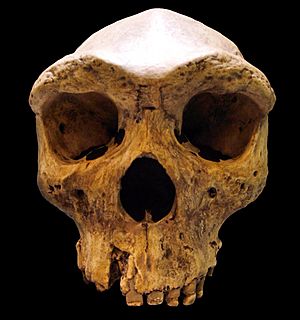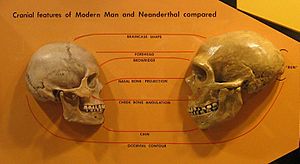Archaic humans facts for kids

Archaic humans is a name given to different types of early humans. They lived before or at the same time as the first modern humans, called Homo sapiens. Modern humans first appeared around 300,000 years ago.
Some of these early human types include:
- Neanderthals (Homo neanderthalensis)
- Denisovans
- Homo rhodesiensis
- Homo heidelbergensis
- Homo naledi
- Homo ergaster
- Homo antecessor
- Homo habilis
Scientists don't always agree on the exact names for these groups. Some put them under Homo sapiens, while others call them different species.
Archaic humans had brains that were about the same size as modern humans. Their brains were typically between 1,200 and 1,400 cubic centimeters. However, they looked different from us. They had very thick skulls and strong brow ridges above their eyes. They also did not have a prominent chin like modern humans do.
Modern humans first appeared in Africa around 300,000 years ago. They slowly replaced the archaic human groups. Some archaic humans might have lived until as recently as 12,000 years ago.
Recent studies suggest that modern humans might have had children with Neanderthals and Denisovans. This means our ancestors mixed with these older human groups. There's also a group called the Red Deer Cave people from China. They might have lived as recently as 11,500 years ago. Some scientists think they could be a mix of Denisovans and modern humans.
What are Archaic Humans?
The term "archaic human" doesn't have one clear definition that all scientists agree on.
Some scientists think that Homo sapiens is one big species with different types, including archaic humans and modern humans. In this view, modern humans are called Homo sapiens sapiens. Archaic humans would then be named like Homo sapiens neanderthalensis (for Neanderthals) or Homo sapiens heidelbergensis.
Other scientists believe that archaic humans and modern humans are separate species. In this case, they use names like Homo rhodesiensis or Homo neanderthalensis.
It's hard to draw clear lines between Homo erectus, archaic humans, and modern humans. For example, the oldest known fossils of modern humans, like the Omo remains (195,000 years old), still have some features that look a bit archaic, such as moderate brow ridges.
How Brains Grew

The appearance of archaic humans is sometimes seen as an example of "punctuated equilibrium." This is a scientific idea where a species changes a lot in a short time. After that, it changes very little for a long time.
The brains of archaic humans grew a lot. For example, Homo erectus had brains around 900 cubic centimeters. Archaic humans had brains that grew to about 1,300 cubic centimeters. Interestingly, since the time of archaic humans, the average brain size of humans has actually gotten a little smaller.
When Did Language Start?
Scientist Robin Dunbar believes that archaic humans were the first to use language. He studied the size of brains and the size of groups that early humans lived in.
He found that because archaic humans had large brains, they likely lived in large groups of over 120 people. Dunbar argues that it would be impossible for such large groups to stay together without language. Without talking, the group would fall apart. In comparison, chimpanzees live in smaller groups of up to 50 individuals.
See also
 In Spanish: Humanos arcaicos para niños
In Spanish: Humanos arcaicos para niños

